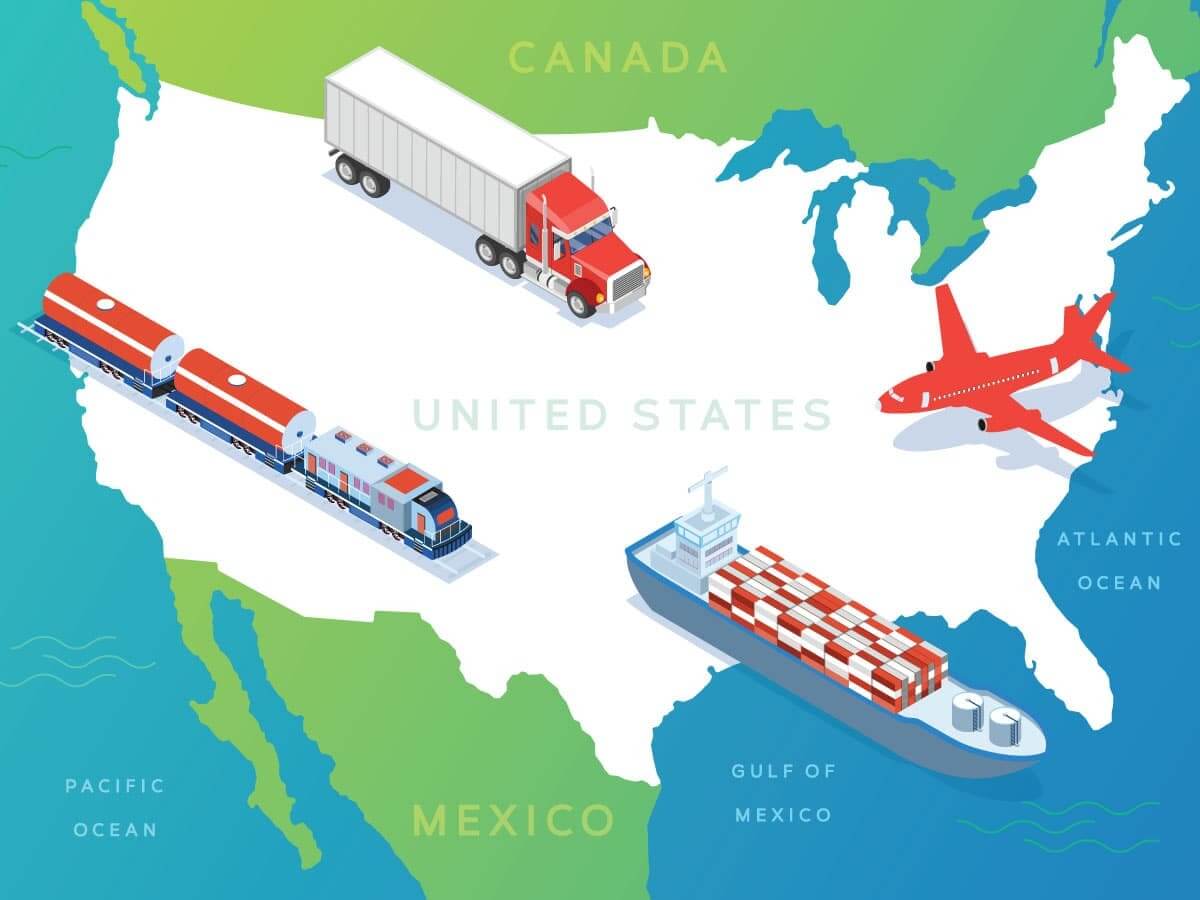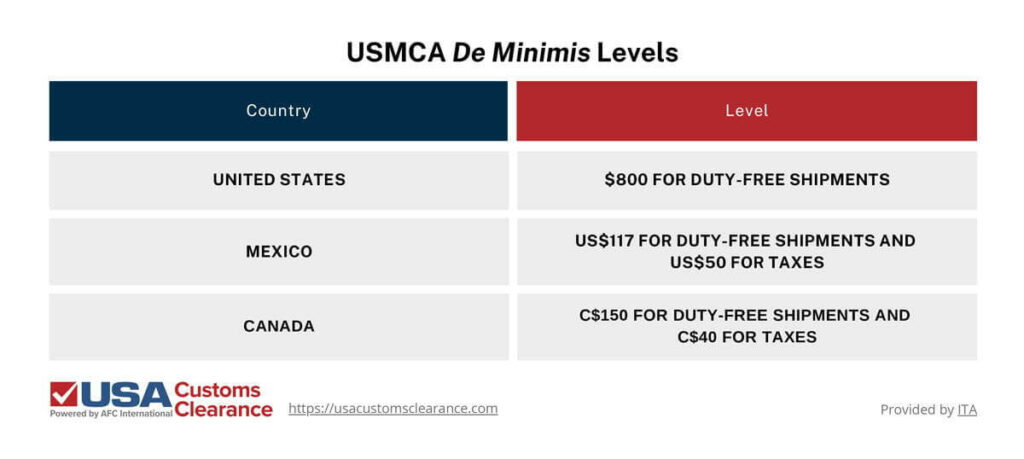
The USMCA is an important free trade agreement (FTA) among the three nations of North America meant to improve trade relations. It also has numerous provisions that help importers in each country. Despite its many positives, numerous importers in the U.S. don’t realize how they can benefit from using the USMCA. We’re going to provide you with some vital information that should know.
Key takeaways:
By the time you’ve finished this article, you’ll know all the essential information you’ll need to use the USMCA to your advantage.
The United States-Canada-Mexico-Agreement (USMCA) is a Free Trade Agreement (FTA) that aims to facilitate trade and economic cooperation between the three countries. It was signed on November 30, 2018, and took effect on July 1, 2020. The USMCA replaced the North American Free Trade Agreement (NAFTA).
There are 34 chapters and numerous side letters that comprise the USMCA. Many of these chapters come from NAFTA, with a few exceptions. Despite sharing many of the same chapters, the USMCA improves upon many of the provisions in NAFTA.
Related: U.S. Free Trade Agreements
The USMCA offers a variety of provisions that enhance trade between its members. I’ll discuss the most notable ones and how they’re beneficial in the following sections.
The USMCA removes tariffs from a variety of goods originating from Mexico and Canada, which means importers can bring these into the U.S. duty-free. While this treatment applies to most goods from these two countries, I’ve listed some notable items that you should consider.
You’ll be able to import these items and many others if they qualify under the USMCA’s rules of origin requirements. However, the origin criteria will differ based on the type of items you’re importing.
There are four General Rules of Origin (ROO) that your goods will have to meet:
Product specific rules of origin can be found in the USMCA Chapter 4. Here you will find requirements for automotive items, textiles and apparel, steel, and much more.
The General ROO and product specific rules of origin are quite lengthy. Rather than tackling these regulations yourself, meet with one of our licensed customs brokers during a consulting session. Additionally, allowing us to serve as your customs clearance team means we'll ensure the entire process follows all proper protocols.

Consult with one of our Licensed Customs Brokers to find out which
USMCA Rules of Origin apply to your imports.
There are many intellectual property (IP) protections under the USMCA as well. Besides protecting the work of companies, the IP provisions in the USMCA help drive innovation and create economic growth.
IP protections include:
The USMCA also created a Committee on Intellectual Property Rights that oversees these the IP protections.
The USMCA sets up an independent investigatory panel that looks into factories that are accused of violating workers’ rights. This panel also has the power to stop shipments that leave factories found to violate labor laws.
Labor protections provided by the USMCA cover the following:
By protecting labor rights, the USMCA ensures there is a more equitable trading environment for each country. That said, many of the provisions target Mexico’s labor practices, which have been historically less strict than the U.S. or Canada.
Importers and exporters of digital products are also protected under the USMCA. The FTA has numerous provisions that make the trade of these products more efficient.
This includes:
The digital trade provisions will set predictable rules that importers and exporters in each country can follow. It will also help facilitate a healthy and robust digital trade market between the three nations.
Chapter 24 of the USMCA has a comprehensive set of environmental obligations.
These provisions include:
Each of these provisions promote sustainable economic growth, while also protecting the natural resources and environment shared by all countries participating in the USMCA.
The USMCA contains provisions that help facilitate the trade of financial services. You can find these rules in Chapter 14 of the USMCA.
Notable provisions include:
Each provision will give U.S. financial institutions and investors a level playing field that allows them to compete fairly with foreign companies.
There is a de minimis provision within the USMCA that allows low-value shipments to enter the participating countries without incurring a customs duty or taxes. I’ve provided a graphic that shows each country’s de minimis levels that must be met to import goods free of duty and sales tax.

The de minimis provisions under the USMCA help SMEs that lack the funds to pay customs duties and taxes. It will also reduce the amount of documentation that business need to provide for low-value shipments. As a result, the importing process for shipments that meet de minimis levels will be simplified.
There have been plans under the Biden Administration to remove U.S. de minimis treatment for goods covered by Section 201, 232, and 301 tariffs. The administration has proposed some other changes to de minimis entries as well.
These include:
Currently, there is a bi-partisan bill that’s been suggested by the U.S. Congress that will make changes to de minimis if passed. It’s called the Fighting Illicit Goods, Helping Trustworthy Importers, and Netting Gains (FIGHTING) for America Act.
Changes this bill would make include:
If you’re an importer that uses de minimis frequently, it’s a good idea to watch the progress of this bill.
Related: Import Costs from Mexico
You don’t need a certificate of origin to apply for preferential tariff treatment under USMCA. Instead, you’ll need to provide nine distinct data elements. In the following section, I’ll discuss these data elements and tell you what document they should be written on.
The nine data elements you’ll need to meet the USMCA’s rules of origin requirements include:
You can provide this data on an invoice or any other document. However, the information you provide on the originating good should be descriptive enough to enable its identification by customs authorities.
The USMCA replaced and improved upon many of the features of NAFTA. In some cases, the USMCA added provisions that didn’t exist under its predecessor. For example, NAFTA had no provisions in place regarding digital trade. The USMCA corrected this by adding robust protections and guidelines for digital products.
Other ways the USMCA upgraded NAFTA include:
We have an entire article that discusses the variations between NAFTA and USMCA if you want to learn more.
Related: NAFTA vs USMCA
The USMCA is intended to last 16 years after its start date. On July 2026, the U.S., Canada, and Mexico will meet to decide if they want to continue the agreement for an additional 16 years. All three countries must unanimously agree to renew the USMCA.
Should the USMCA fail to be renewed in 2026, it will remain in place until July 1, 2036. This means importers won’t be immediately impacted by the decision.
If renewal doesn’t occur in 2026, each country will hold a joint review once a year for the remaining 10 years. During these meetings, each party can express their desire to renew the USMCA (or not).
Should all three countries not renew the USMCA during joint reviews held in 2026 or the subsequent years, the FTA will be permanently terminated on July 1, 2036.
Should the U.S., Mexico, and Canada fail to renew the USMCA in 2026, there won’t be much need for concern amongst importers. The FTA will remain in force for an additional 10 years. That said, there are still some things that you can do if the USMCA isn’t renewed.
This includes:
You should continue to monitor any developments regarding the renewal or renegotiation surrounding the USMCA. This will help you anticipate changes occurring in the trade community.
Even if the USMCA isn’t renewed, changes in its provisions might change in the future. Therefore, watching trade developments will allow you to prepare for any revisions.
Meeting with trade experts that are educated about international trade agreements can help as well. They’ll provide you with more insights on how to navigate the changes that could occur if the USMCA renewal fails.
The USMCA offers many benefits for importers, which means you have a vested interest in it continuing. You can join with other importers and advocate for the USMCA to continue.
On February 1st, 2025, President Trump issued executive orders that impose new tariffs on Canada and Mexico. The tariffs will be a 25% ad valorem duty rate, in addition to any other duties, fees, and related charges on imports.
Each executive order says that tariffs will cover “all articles”, which suggests the 25% ad valorem tariff will apply to all products imported for consumption. Energy or energy resources imported from Canada will receive a lower tariff of 10%. However, there is a possibility this could be raised in the future.
Originally, the new tariffs will begin at 12:01 a.m. on February 4th, 2025. However, Mexico and Canada were able to reach an agreement with the U.S., which resulted in a one-month postponement of the new tariffs.
Other provisions in the executive order that impact U.S. importers include:
Trump issued these executive orders using the International Emergency Economic Powers Act (IEEPA). On March 4th, the one-month postponement of tariffs on Mexico and Canada came to an end. The 25% tariff on Mexico and Canada and the 10% tariff on Canadian energy products have now taken effect. There is no indication as to when these tariffs will come to an end.
On March 5th, President Trump decided to exempt automobile imports coming from Mexico and Canada from the 25% tariff. He made this decision at the request of General Motors, Ford, and Stellantis. The exemption is temporary and will end after one month.
Trump decided on March 6th, 2025, to postpone the 25% tariff for certain Mexican and Canadian goods that qualify for duty-free entry under the USMCA. That said, the 25% tariff will still apply to about 50% of imports from Mexico and 60% of imports from Canada.
On March 4th, 2025, Canada responded with their own 25% tariffs that will be placed on $20 billion worth of U.S. goods. By March 25th, an additional $86.5 billion of U.S. products will also be subject to the tariffs as well.
The USMCA can be difficult for importers to understand. The experts at USA Customs Clearance are ready to offer their support. We have a team of licensed customs brokers and import specialists with years of experience.
They’ll be able to guide you through the complexities of the USMCA and other FTAs. We also offer services and documents that can help you when importing.
Start your importing endeavor with USA Customs Clearance with one of our services. You can also reach our team at (855) 912-0406 if you have any questions.

Our Licensed Customs Brokers can guide you through the regulations of
USMCA during a consulting session.
 Copy URL to Clipboard
Copy URL to Clipboard
Add your first comment to this post